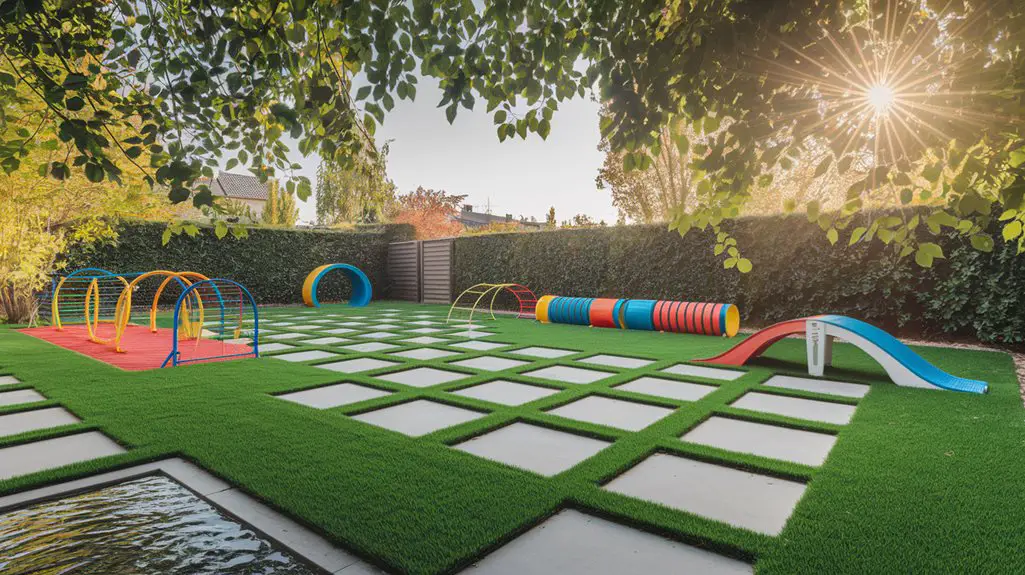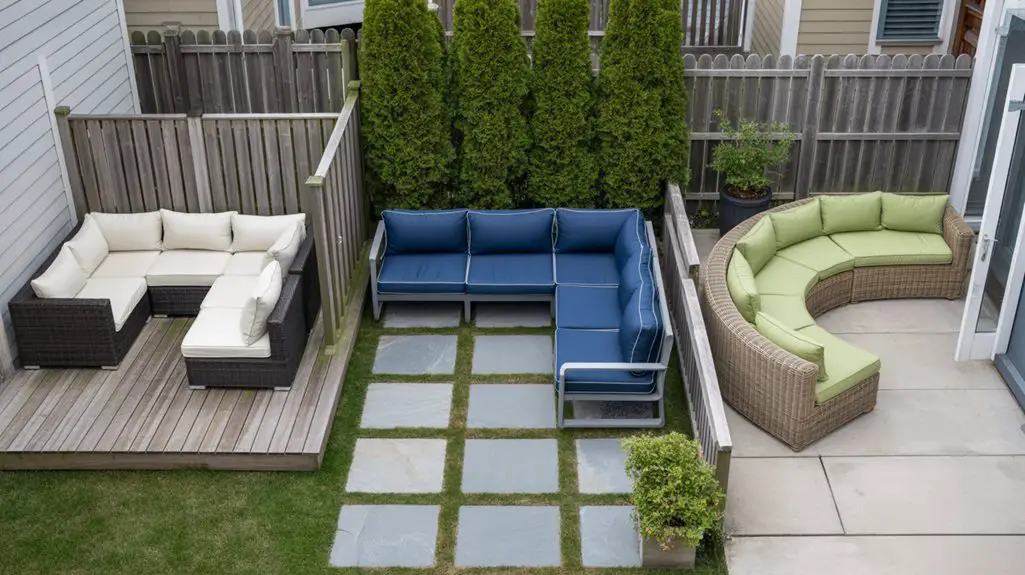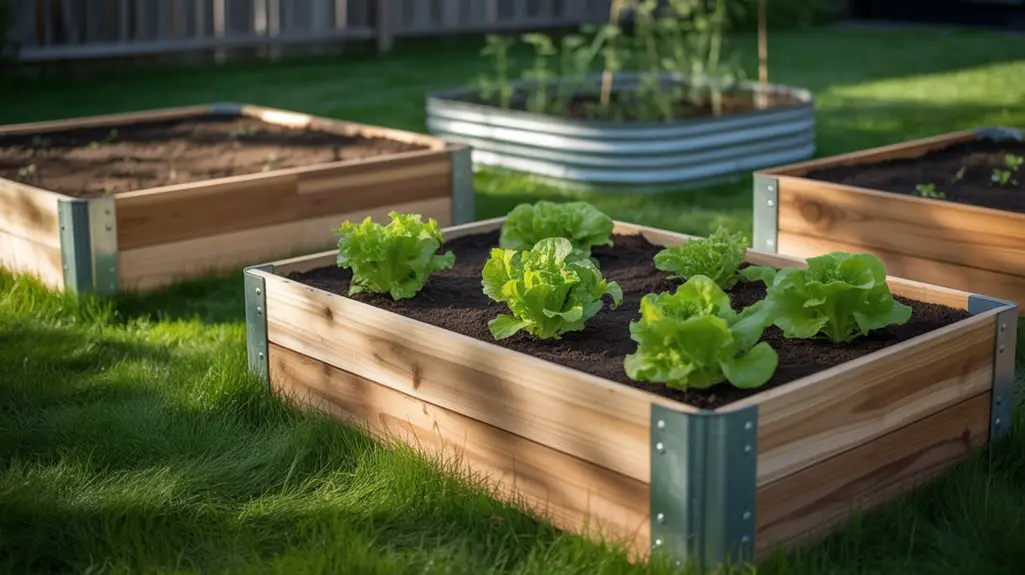Is a backyard truly optimized if it doesn’t account for your pet’s biological imperatives? You’ll find that purposefully designed outdoor spaces can greatly reduce common health issues like obesity, destructive behaviors, and anxiety in domestic animals. A thoughtful backyard design addresses species-specific needs while creating environmental enrichment opportunities that stimulate both physical and mental development. The transformative effects on your pet’s wellbeing will become evident as we explore each essential element of pet-centric landscape design.
Health Benefits of Pet-Friendly Outdoor Spaces
When designed ideally, pet-friendly outdoor spaces deliver significant physiological and psychological benefits for canines and felines. Your pets’ cardiovascular health improves through access to adequate running zones, agility features, and exploration opportunities. Regular outdoor exercise helps maintain optimal body weight, reducing risks of obesity-related conditions like diabetes and joint disease.
Beyond physical benefits, these environments stimulate cognitive function through sensory enrichment. Dogs and cats require territorial patrol spaces and secure perimeters to reduce stress cortisol levels.
Environmental enrichment through varied terrain, climbing structures, and hunting simulation features promotes neurological development and prevents destructive behavioral patterns. Incorporating multiple pets’ needs into the design ensures that all animals can thrive and engage positively in this stimulating environment.
You’ll notice decreased veterinary intervention needs when your pets access properly designed outdoor spaces that accommodate species-specific exercise requirements and natural behavioral patterns.
Understanding Your Pet’s Exercise Needs

Before designing any backyard space, you must accurately assess your pet’s specific exercise requirements based on species, breed, age, and health status.
Dogs’ needs vary dramatically—herding and working breeds require 60-90 minutes of vigorous daily activity, while brachycephalic breeds need monitored, moderate exercise to prevent respiratory distress.
For cats, vertical space and prey-simulation zones promote natural hunting behaviors and prevent obesity.
Senior pets benefit from gentle terrain with soft surfaces to minimize joint strain, while puppies and kittens need safe exploration zones with mental stimulation components.
Monitor your pet’s exercise response—panting, recovery time, and post-activity mobility can indicate whether your current provisions are appropriate.
Consult your veterinarian for breed-specific recommendations, especially for animals with orthopedic conditions, cardiac issues, or metabolic disorders. Additionally, consider incorporating designated play areas that facilitate safe and engaging activities for your small dogs to enjoy.
Safety Features Every Pet Backyard Requires

Creating a safe backyard environment requires implementation of multiple protective features that address species-specific hazards and prevent common trauma scenarios.
You’ll need secure fencing that extends below ground level for diggers and reaches sufficient height to prevent jumpers from escaping. Remove toxic plants such as lilies, azaleas, and sago palms that can cause acute hepatic or renal failure in domestic animals.
Install sturdy barriers around pools, ponds, and hot tubs to prevent accidental drowning, particularly in brachycephalic breeds with limited swimming capacity.
Secure compost bins and trash containers to prevent ingestion of mycotoxins or foreign bodies. Avoid cocoa mulch, which contains theobromine that’s toxic to canines.
Store lawn chemicals, fertilizers, and pesticides in inaccessible locations to prevent dermal contact or oral exposure. Additionally, consider incorporating pet-friendly landscaping that includes safe plants and features designed for active play.
Durable Materials for High-Energy Animals
Once you’ve established safety parameters for your pets, the selection of appropriate materials becomes the next fundamental consideration for your backyard design.
High-energy animals exert significant force on surfaces, necessitating materials that withstand repeated impact and abrasion.
For ground surfaces, consider K9-grade artificial turf with antimicrobial properties or compressed decomposed granite that resists digging.
Install rubber mulch in play zones—it’s non-toxic, doesn’t splinter, and absorbs impact energy during high-velocity activities.
Boundary structures require reinforcement; opt for cedar or redwood fencing treated with pet-safe sealants rather than pressure-treated lumber containing arsenic compounds.
For play equipment, marine-grade stainless steel resists corrosion from saliva and urine while maintaining structural integrity under dynamic loads.
Avoid plastics that degrade with UV exposure, releasing potentially harmful phthalates that pets might ingest. Additionally, incorporating durable materials into your design can enhance the longevity and safety of your pet-friendly space.
Creating Dedicated Play Zones for Different Activities
While durable materials form the foundation of your pet-friendly backyard, strategic zone division maximizes both functionality and behavioral enrichment. Establishing distinct areas addresses species-specific locomotor patterns and enrichment needs.
| Zone Type | Behavioral Benefits |
|---|---|
| Digging Pit | Satisfies natural excavation drive |
| Agility Course | Develops proprioception and coordination |
| Rest Area | Facilitates thermal regulation |
| Scratching Post | Maintains claw health |
| Scent Garden | Stimulates olfactory engagement |
Create these zones based on your pet’s ethogram—the catalog of species-typical behaviors. Position high-activity zones away from property boundaries to minimize territorial displays. Guarantee each zone includes appropriate substrate depth for joint health; puppies require 2-3 inches of cushioning material for developing growth plates, while geriatric animals benefit from anti-inflammatory medicinal plantings like calendula in rest zones. Incorporating pet-friendly outdoor entertaining features can enhance the overall experience for both pets and their owners.
Weather Considerations for Year-Round Enjoyment
As seasons fluctuate throughout the year, proper environmental modifications become essential for maintaining ideal thermoregulatory conditions for active pets.
You’ll need to incorporate shaded retreats utilizing deciduous vegetation or pergolas to mitigate hyperthermia risk during summer months. Consider installing cooling stations with recirculating water features that allow for both hydration and immersion.
For winter accommodation, implement wind barriers along prevailing cold fronts and provide insulated shelters with proper bedding substrates.
South-facing exercise areas maximize solar exposure during colder periods while maintaining adequate footing through proper drainage systems.
Transitional seasons require adaptable microenvironments that can be modified as ambient temperatures fluctuate.
Install permeable surfaces that minimize mud accumulation during precipitation events while facilitating quick drying to prevent dermatological complications and maintain consistent activity levels year-round. Additionally, integrating sustainable backyard designs can enhance the overall ecological footprint of your pet-friendly space.
Balancing Aesthetics and Functionality in Pet Landscapes
Creating harmonious outdoor environments requires strategic integration of design elements that satisfy both human aesthetic preferences and canine behavioral requirements.
You’ll find ideal results when incorporating non-toxic plant species (Camellia spp., Callistemon spp.) that withstand canine territorial marking while maintaining visual appeal.
Implement designated elimination zones using absorption-efficient substrates like pea gravel bordered by aesthetic hardscaping. This permits natural elimination behaviors while containing potential landscape damage.
For active pets, incorporate circular pathway designs that accommodate instinctual perimeter-checking behaviors without creating worn lawn tracks.
When selecting outdoor furniture, prioritize weatherproof, scratch-resistant materials (polyethylene, powder-coated aluminum) that maintain aesthetic integrity despite animal contact.
Elevated planters provide visual interest while protecting sensitive vegetation from excavation behaviors commonly exhibited in territorial canines. Additionally, incorporating pet-friendly landscaping can enhance the overall safety and enjoyment of your outdoor space.
Conclusion
You’ll notice significant improvements in your pet’s health by designing an activity-optimized backyard. Studies show that dogs with access to enriched outdoor spaces experience 28% fewer behavioral issues than those without adequate exercise options. The physiological benefits extend beyond weight management, including improved cardiovascular function, enhanced proprioception, and reduced inflammatory markers. Don’t underestimate the therapeutic value that strategic environmental design contributes to your companion animal’s longevity.




